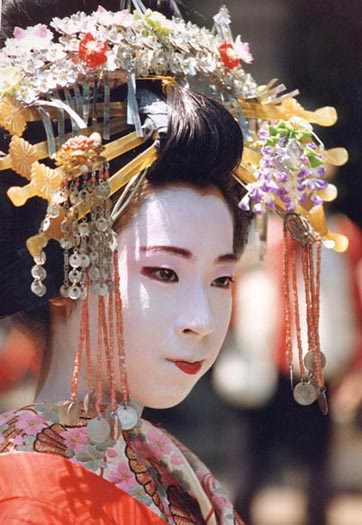Oiran and Tayuu were the highest class of courtesans. They were not Geisha, nor were Geisha Oiran or Tayuu.
Geisha used to work along side Oiran and Tayuu though, entertaining in a conversational manner and also dancing, singing and playing music. They were not allowed to compete with the Oiran or Tayuu for their customers, and many strict sumptuary regulations were placed on them to enforce this.
Tayuu and Oiran also offered conservative intimacies. They were courtesans as opposed to prostitutes as they provided traditional entertainment in the performing arts much as the geisha did. Thus, courtesan is the preferred term as prostitutes do not provide these services. Tayuu were supposed to be as an ideal wife, for a single night at least. As married women in the Edo period would have, they blackened their teeth, and tied their obi in front. It is thought by some that this was for easy removal, but it was also just another common practice for married women, symbolic and akin to the modern practice of wearing a wedding ring. It was taboo for Tayuu or Oiran to remove their kimono during intimacy. Evidence for this can be found in shunga prints, in which courtesans are almost always depicted with their clothes still on. They only entertained the noblest of samurai and ruling lords and often went to the Palaces of Kyoto. Unlike prostitutes of the day, they could also choose or deny anyone that they wished to spend time with and usually did not have sex on their first meeting. In Yoshiwara,
The rise of the geisha ended the era of the Tayuu. Geisha practiced the common entertainments enjoyed by the people of that time and were much more accessible to the casual visitor. Their popularity grew rapidly and eclipsed that of the Tayuu. The last oiran record was in 1761. Oiran went extinct and were replaced by Tayuu in the 1760s. During World War II, when any show of luxury was seen as negative, Tayuu culture suffered also. Increasingly strict rules on prostitution made continuation of the vocation difficult.
After the prostitution laws came into place in 1956, there was one Tayuu house that remained open, to serve as a museum and to preserve the artistic and cultural elements of the Tayuu lifestyle. This particular house is called the Wachigaiya, located in the Shimabara hanamachi.
The few remaining women still currently practicing the arts of the Tayuu (without the sexual aspect) do so as a preservation of cultural heritage, thay could possibly have been geisha previously who,. in addition to their prior knowledge in the traditional arts, decided to help preserve the artistic culture of the Tayuu.

Comments
Post a Comment